Learning objectives
- Describe the pathology, common causes, and symptoms of bronchiectasis
- Manage patients with bronchiectasis
Definition
- Bronchiectasis is characterized by prolonged abnormal dilatation of bronchi with chronic inflammation
- patients are extremely productive of sputum with a predisposition to either chronic infection or colonization with intermittent acute episodes of infection
Causes
- Cystic fibrosis
- Tuberculosis
- Smoking
- COPD
- Asthma
- Childhood pneumonia or recurrent adult infections
- Bronchial catrillage deficiency
- Abnormal ciliary motility (Kartageners)
- Hypogammaglobulinaemia
- Immunodeficiency
- Inhaled foreign body
- Tumor
Signs & symptoms
- High sputum production: Severe bronchiectasis patients can produce up to 500 mL of purulent sputum per day, which gets dramatically worse during an acute exacerbation
- Hemoptysis from areas of severe inflammation
- Pulmonary hypertension and cor pulmonale may develop in long-standing disease
- Metastatic abscess formation can occur
- Amyloidosis (rare)
Treatment
- Chest physiotherapy with percussion and postural drainage
- Early intervention with antibiotics to prevent acute exacerbations
Anesthetic management

Suggested reading
- Pollard BJ, Kitchen, G. Handbook of Clinical Anaesthesia. Fourth Edition. CRC Press. 2018. 978-1-4987-6289-2.
- Chalmers, J.D., Chang, A.B., Chotirmall, S.H. et al. Bronchiectasis. Nat Rev Dis Primers 4, 45 (2018).
We would love to hear from you. If you should detect any errors, email us customerservice@nysora.com







